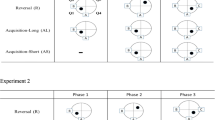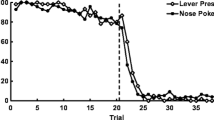Abstract
Rats were trained in a Y maze on a two-choice simultaneous brightness discrimination with light as S+ and dark as S− (position irrelevant). Half of the animals were then switched to reversal, where the reinforcement contingencies of the original training were reversed, and the other half were switched to nonreversal, in which they learned a simultaneous right-left discrimination. Nonreversal was acquired faster than reversal in saline injected animals. The administration of 1 mg/kg d-amphetamine did not affect the acquisition of the initial brightness discrimination and of nonreversal. In contrast, the drug facilitated dramatically reversal learning.
The results indicate that amphetamine enhances the attention to, or the associability of, the discriminative stimuli, leading to rapid learning to these stimuli under changed contingencies of reinforcement.
Similar content being viewed by others
References
Ahlenius S, Carlsson A, Engel J (1975). Antagonism by baclophen of the d-amphetamine-induced disruption of successive discrimination in the rat. J Neural Transm 36:327–333
Bleuler E (1966) Dementia praecox or the group of schizophrenias. Academic Press, New York (originally published in 1911)
Broen WE (1968) Schizophrenia: Research and theory. Academic Press, New York
Brookshire KH, Warren JM, Ball GB (1961) Reversal and transfer following overtraining in rat and chicken. J Comp Physiol Psychol 54:98–102
Calhoun WH, Jones EA (1974) Methamphetamine's effect on repeated acquisition with serial discrimination reversals. Psychopharmacologia 39:303–308
Evenden JL, Robbins TW (1983) Dissociable effects of d-amphetamine, chlordiazepoxide and α-flupenthixol on choice and rate measures of reinforcement in the rat. Psychopharmacology 79:180–186
Evenden JL, Robbins TW (1985) The effects of d-amphetamine, chlordiazepoxide and alpha-flupenthixol on food reinforced tracking of a visual stimulus by rats. Psychopharmacology 85:361–366
Frith CD (1979) Consciousness, information processing and schizophrenia. Br J Psychiatry 134:225–235
Heise GA, Lilie NL (1970) Effects of scopolamine, atropine and d-amphetamine on internal and external control of responding on non-reinforced trials. Psychopharmacologia 18:38–49
Heise GA, Milar KS (1984) Drug and stimulus control. In: Iversen LL, Iversen SD, Snyder SH (eds) Handbook of Psychopharmacology, Vol 18, Plenum Press, New York, pp 129–190
Hill RT (1970) Facilitation of conditioned reinforcement as a mechanism of psychomotor stimulation. In: Costa E, Garattini S (eds) Amphetamine and related compounds. Raven Press, New York, pp 781–795
Kelleher RT (1956) Discrimination learning as a function of reversal and nonreversal shifts. J Exp Psychol 51:379–384
Koek W, Slangen JL (1983) Effects of d-amphetamine and morphine on discrimination: signal detection analysis and assessment of response repetition in the performance deficits. Psychopharmacology 80:125–128
Kokkinidis L, Anisman H (1980) Amphetamine models of paranoid schizophrenia: An overview and elaboration of animal experimentation. Psychol Bull 3:551–579
Ksir C (1975) Scopolamine and amphetamine effects on discrimination: interaction with stimulus control, Psychopharmacologia 43:37–41
Ksir C, Slifer B (1982) Drug effects on discrimination performance at two levels of stimulus control. Psychopharmacology 76:286–290
Kulig BM, Calhoun WH (1972) Enhancement of successive discrimination reversal learning by methamphetamine. Psychopharmacologia 27:233–240
Lyon M, Robbins TW (1975) The action of central nervous system stimulant drugs: a general theory concerning amphetamine effects. In: Essman WB, Valzelli L (eds) Current developments in psychopharmacology, vol 2. Spectrum, New York, pp 79–163
Mackintosh NJ (1962) The effect of overtraining and reversal and nonreversal shift. J Comp Physiol Psychol 55:555–559
Mackintosh NJ (1974) The psychology of animal learning. London, Academic Press
Mackintosh NJ (1983) Conditioning and associative learning. Oxford University Press: New York
Magaro PA (1980) Cognition in schizophrenia and paranoia: the intergration of cognitive processes. Lawrence Erlbaum, Hillsdale
Matthysse S, Spring BJ, Sugarman J (eds) (1979) Attention and information processing in schizophrenia. Pergamon Press, Oxford
Moerschbaecher JM, Thompson DM (1980) Effects of phencyclidine, pentobarbital and d-amphetamine on the acquisition and performance of conditional discriminations in monkeys. Pharmacol Biochem Behav 13:887–894
Nielsen EB (1981) Effects of d-amphetamine and LSD on simultaneous discrimination. In: Bradshaw CM, Sabadi E, Lowe CF (eds) Quantification of steady-state operant behavior. Elsevier, Amsterdam, pp 461–464
Nielsen EB, Appel JB (1983) The effects of drugs on the discrimination of color following a variable delay period: A signal detection analysis. Psychopharmacology 80:24–28
Payne RW (1966) The measurement and significance of overinclusive thinking and retardation in schizophrenic patients. In: Hoch P, Zubin J (eds) Psychopathology of schizophrenia. Grune and Stratton, New York, pp 77–97
Ridley RM, Baker HF, Haystead TAJ (1981a) Perseverative behavior after amphetamine: Dissociation of response tendency from reward association. Psychopharmacology 25:283–286
Ridley RM, Haystead TAJ, Baker HF (1981b) An analysis of visual object reversal learning in the marmoset after amphetamine and haloperidol. Pharmacol Biochem Behav 14:345–351
Robbins TW, Sahakian BJ (1983) Behavioral effects of psychomotor stimulant drugs: clinical and neuropsychological implications. In: Creese I (ed) Stimulants: Neurochemical, behavioral and clinical perspectives. Raven Press, New York, pp 301–338
Segal DS, Janowsky DW (1978) Psychostimulant-induced behavioral effects: Possible models of schizophrenia. In: Lipton A, DiMascio A, Killam KF (eds) Psychopharmacology: A generation of progress. Raven Press, New York
Segal DS, Schuckit MA (1983) Animal models of stimulant-induced psychosis. In: I Creese (ed), Stimulants: Neurochemical, behavioral and clinical perspectives. Raven Press, New York
Shakow D (1962) Segmental set: A theory of the formal psychological deficit in schizophrenia. Arch Gen Psychiatry 6:17–33
Solomon PR, Crider A, Winkelman JW, Turi A, Kramer RM, Kaplan IJ (1981) Disrupted latent inhibition in the rat with chronic amphetamine or haloperidol-induced supersensitivity: Relationship to schizophrenic attention disorder. Biol Psychiatry 16:619–537
Stein L (1964) Self-stimulation of the brain and the central stimulant action of amphetamine. Fed Proc 23:836–850
Sutherland NS, Mackintosh NJ (1971) Mechanisms of animal discrimination learning. Academic Press, New York
Tighe TJ (1964) Reversal and nonreversal shifts in monkeys. J Com Physiol Psychol 58:324–326
Weiner I, Ben-Horin E, Feldon J (1986) Amphetamine and the overtraining reversal effect. Pharmacol Biochem Behav (in press)
Weiner I, Bercovitz H, Feldon J (1985) The abolition of the partial reinforcement extinction effect (PREE) by amphetamine. Psychopharmacology 86:318–323
Weiner I, Lubow RE, Feldon J (1981) Chronic amphetamine and latent inhibition. Behav Brain Res 2:285–286
Weiner I, Lubow RE, Feldon J (1984) Abolition of the expression but not the acquisition of latent inhibition by chronic amphetamine in rats. Psychopharmacology 83:194–199
Author information
Authors and Affiliations
Additional information
Offprint request to: I. Weiner
Rights and permissions
About this article
Cite this article
Weiner, I., Feldon, J. Reversal and nonreversal shifts under amphetamine. Psychopharmacology 89, 355–359 (1986). https://doi.org/10.1007/BF00174374
Received:
Revised:
Issue Date:
DOI: https://doi.org/10.1007/BF00174374




